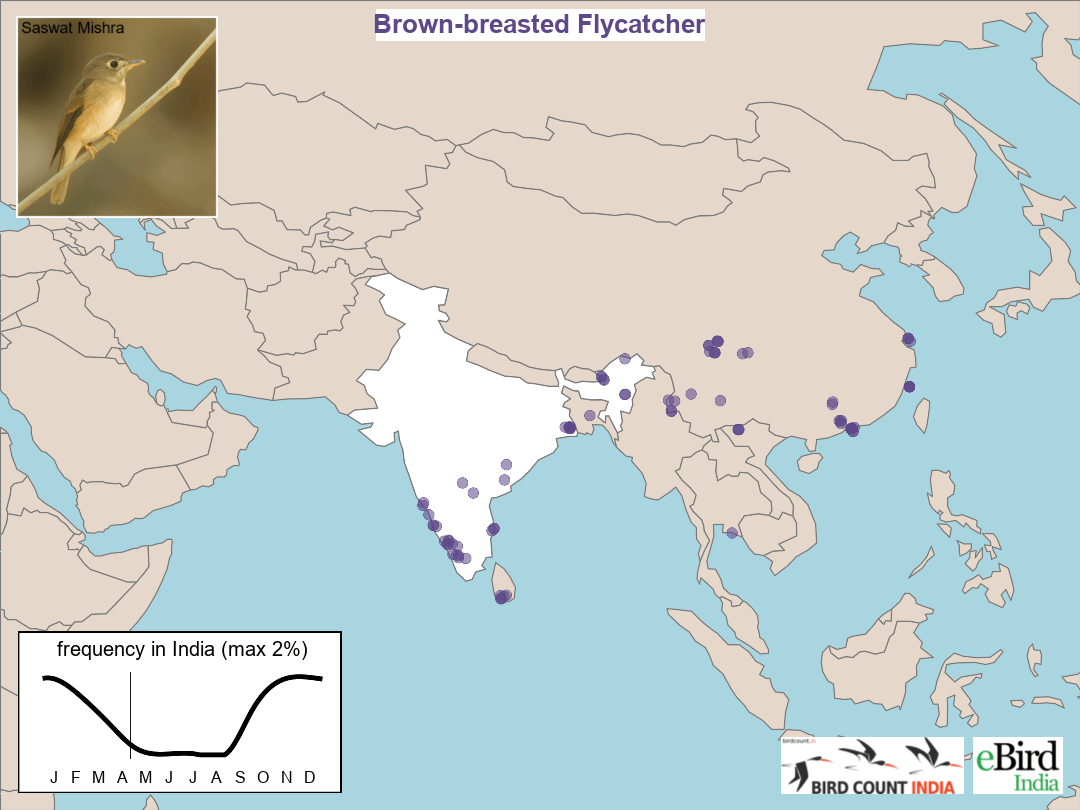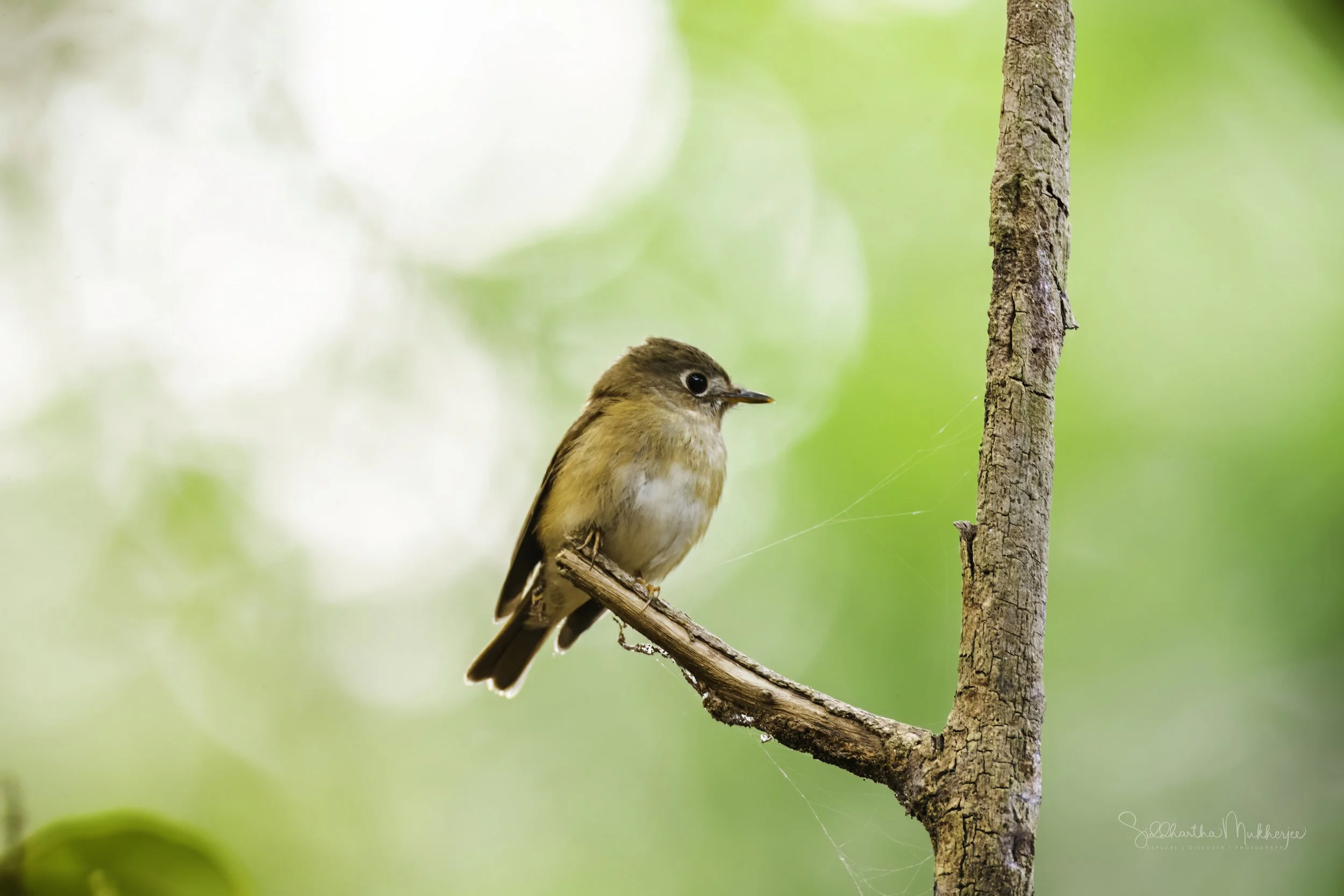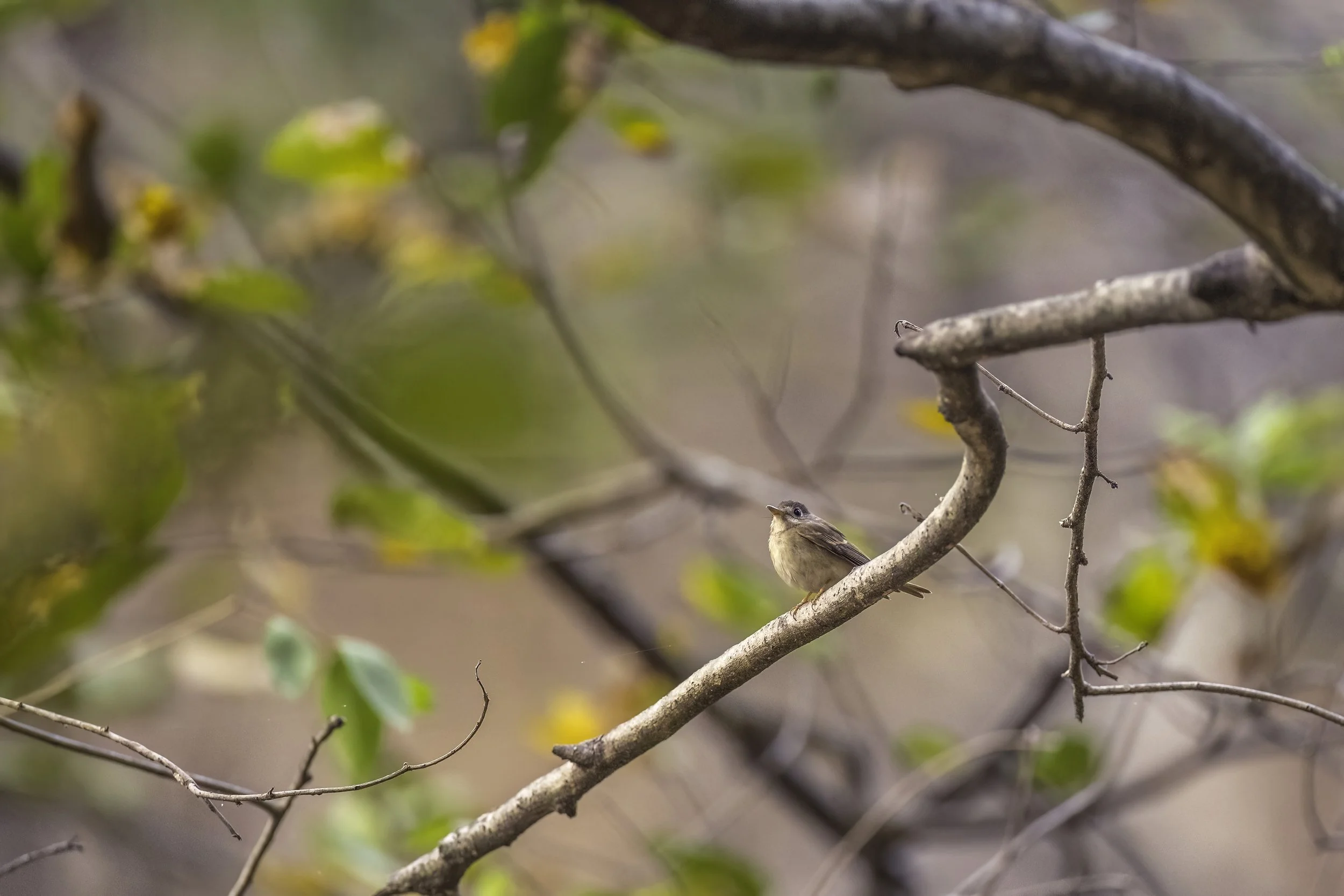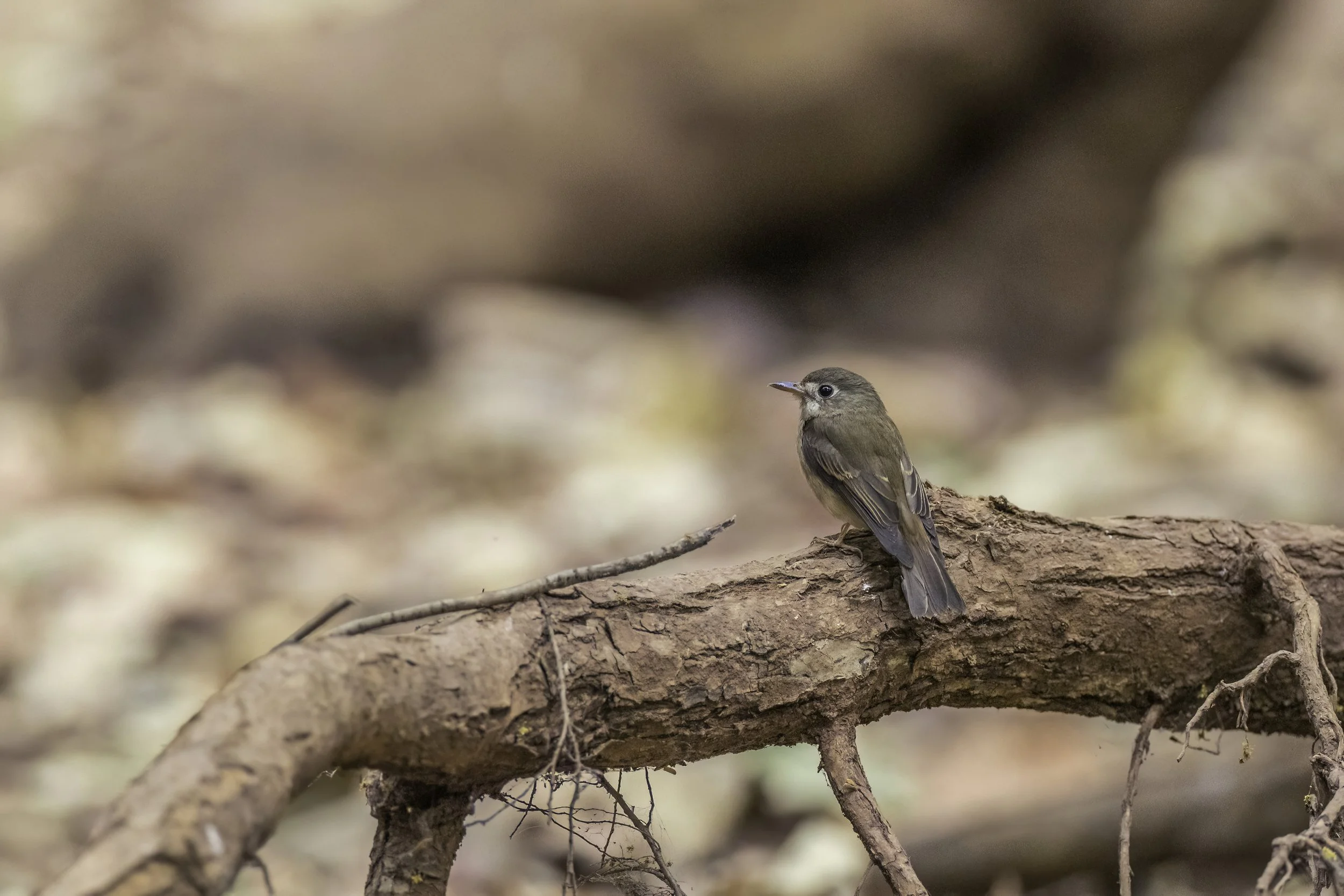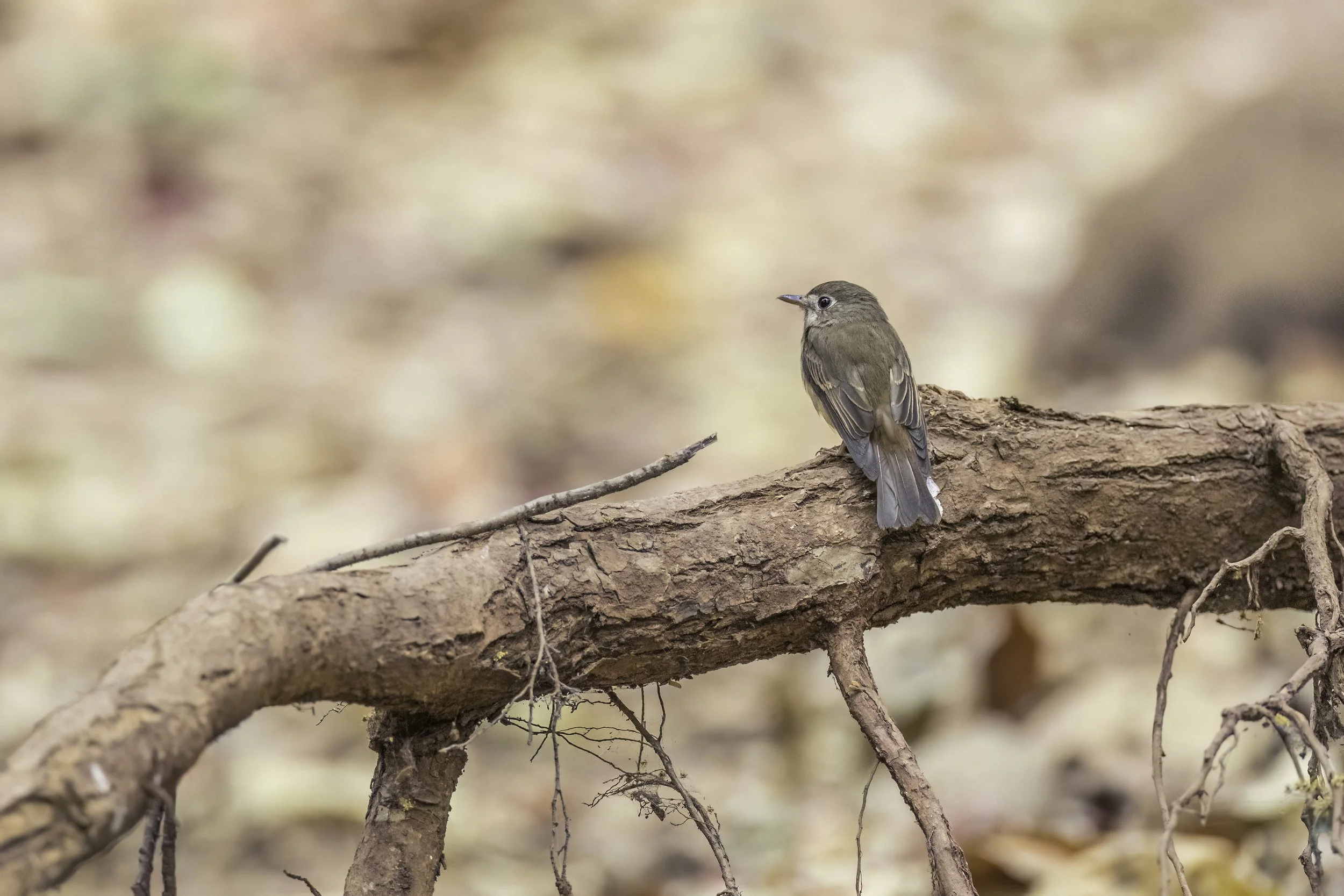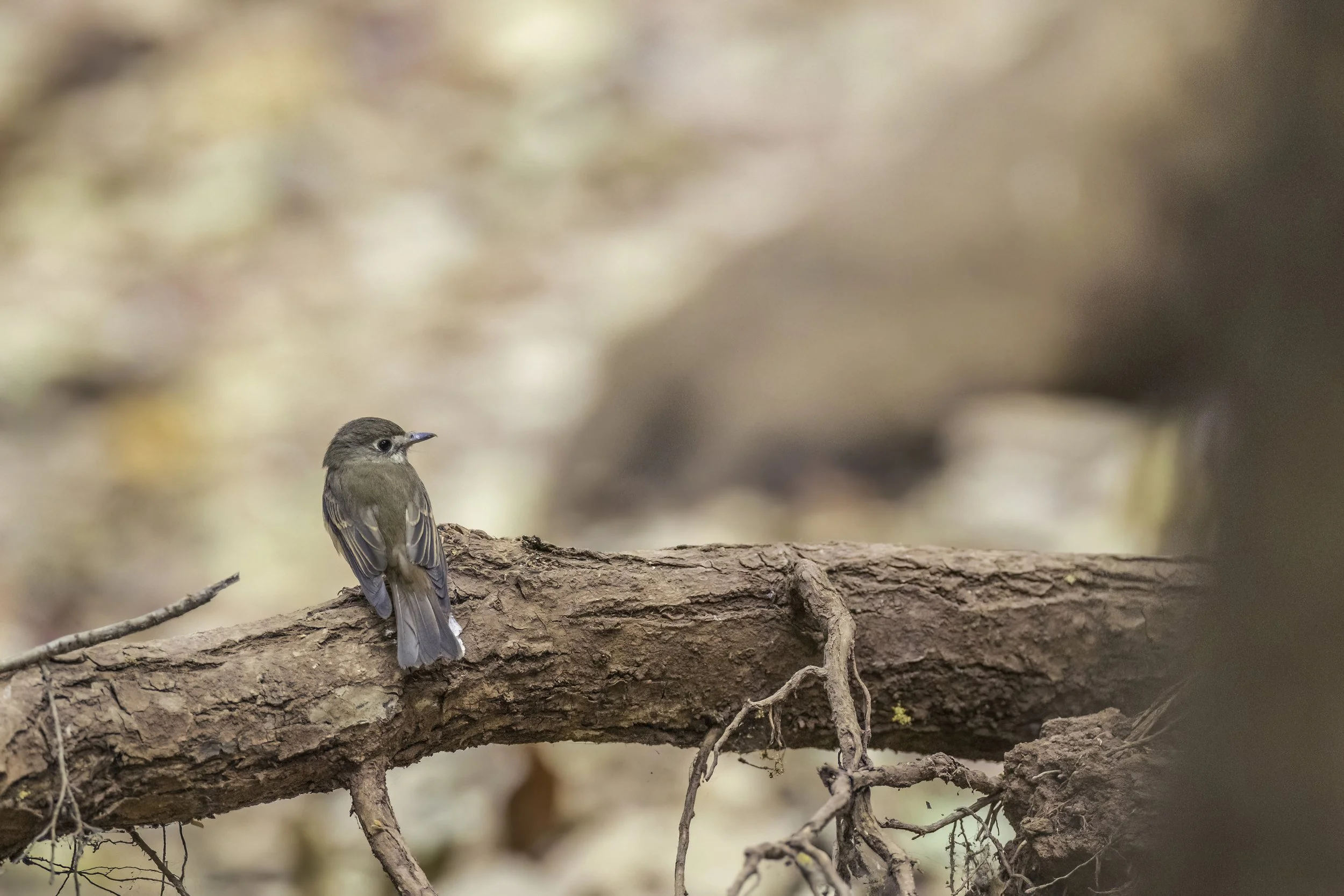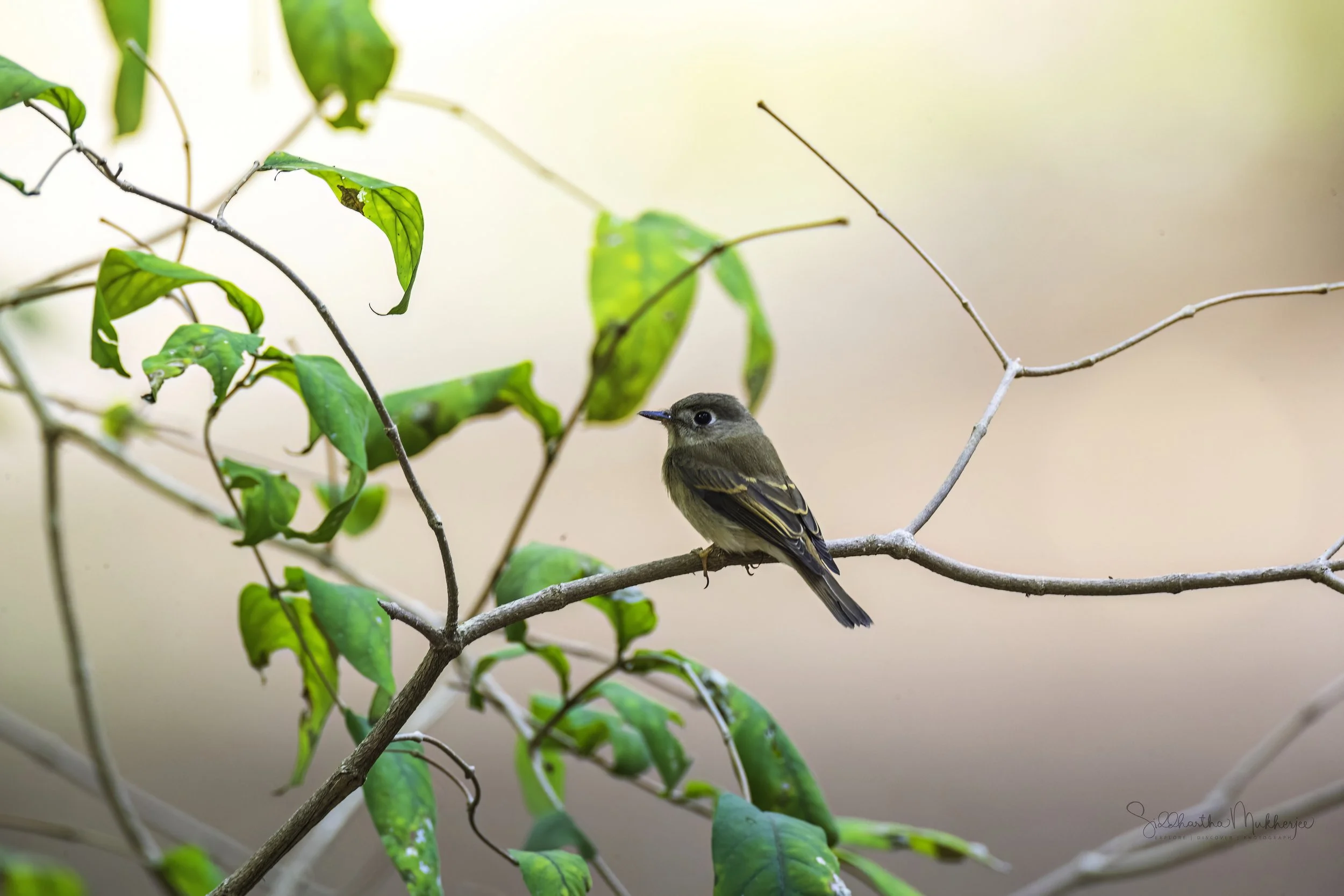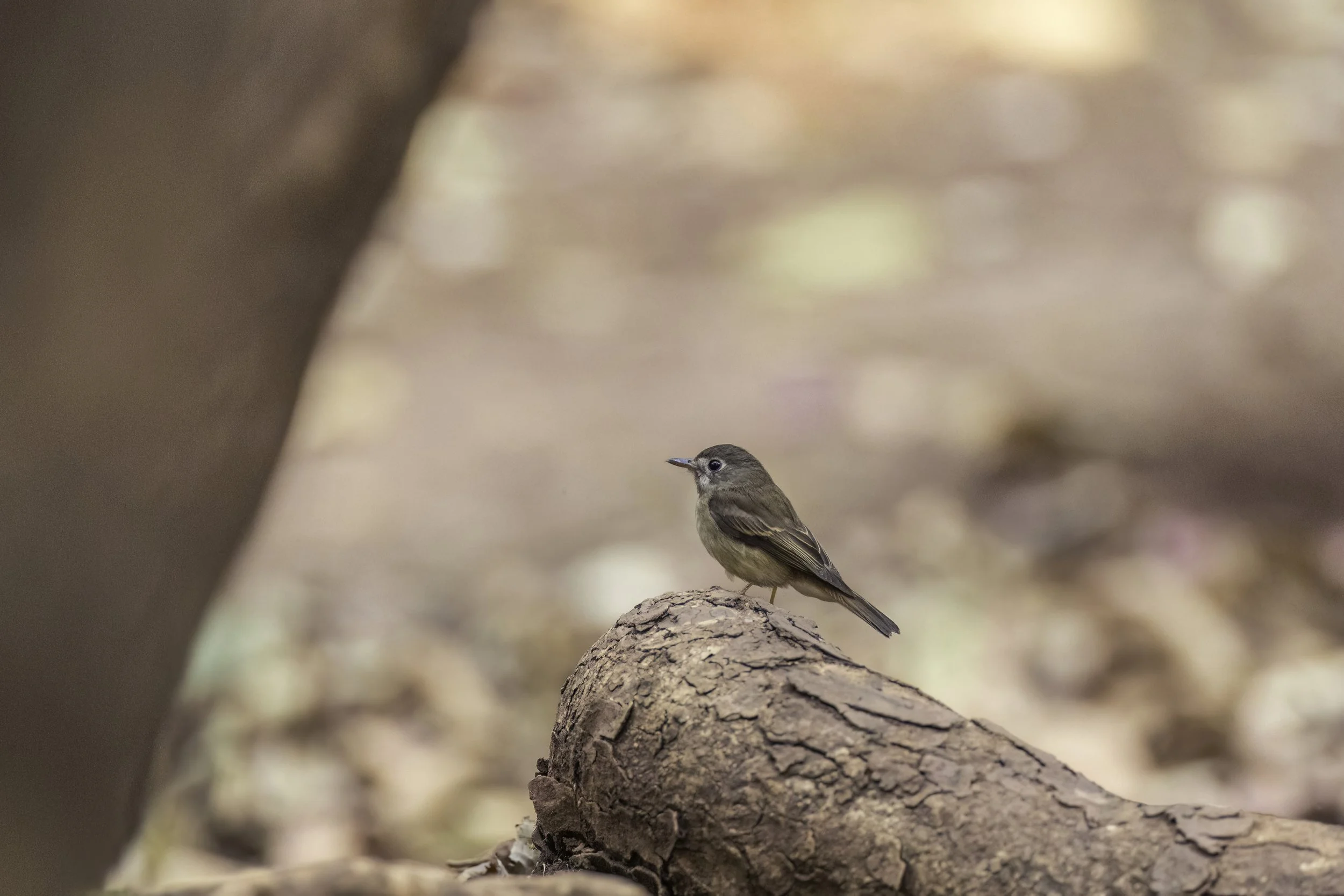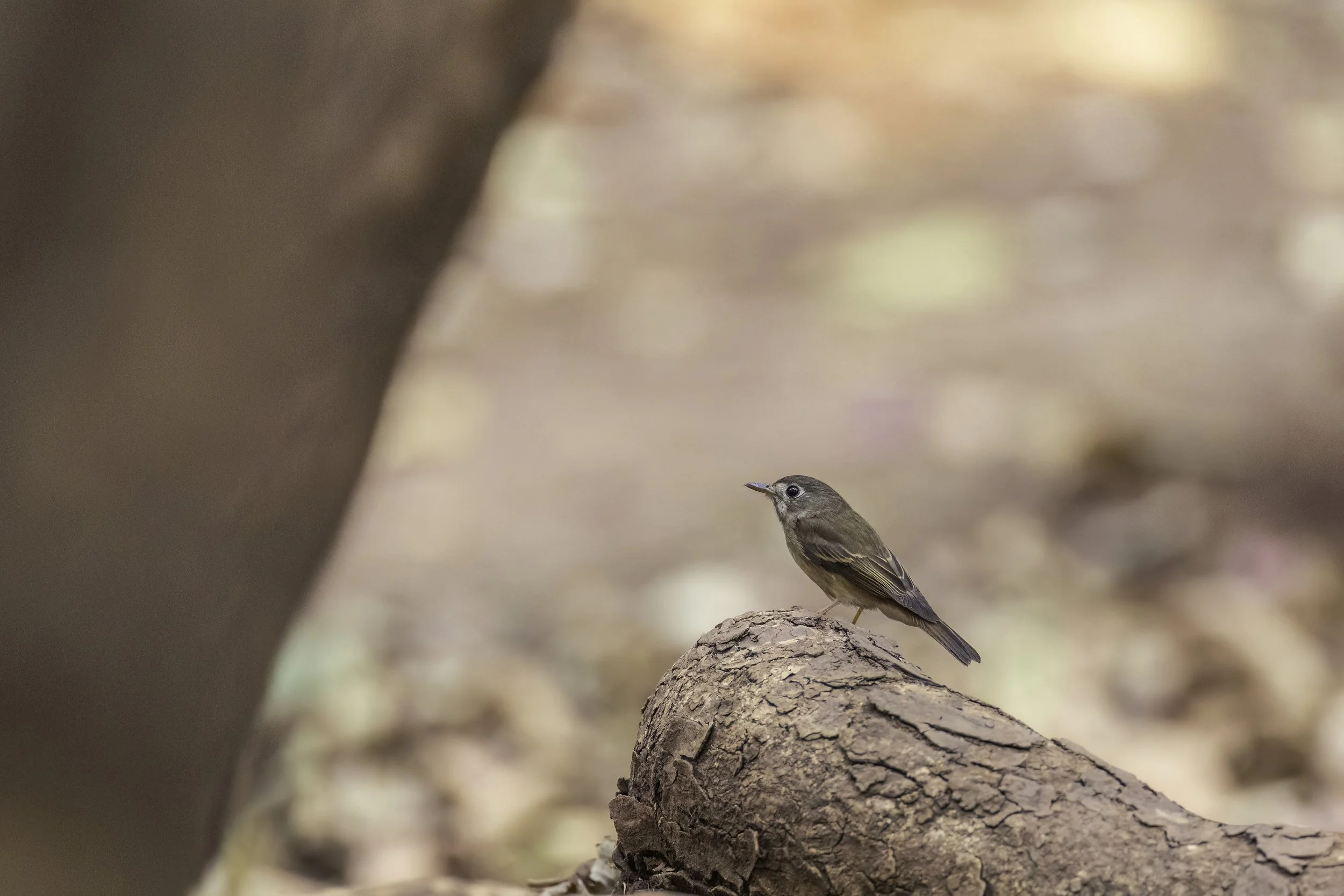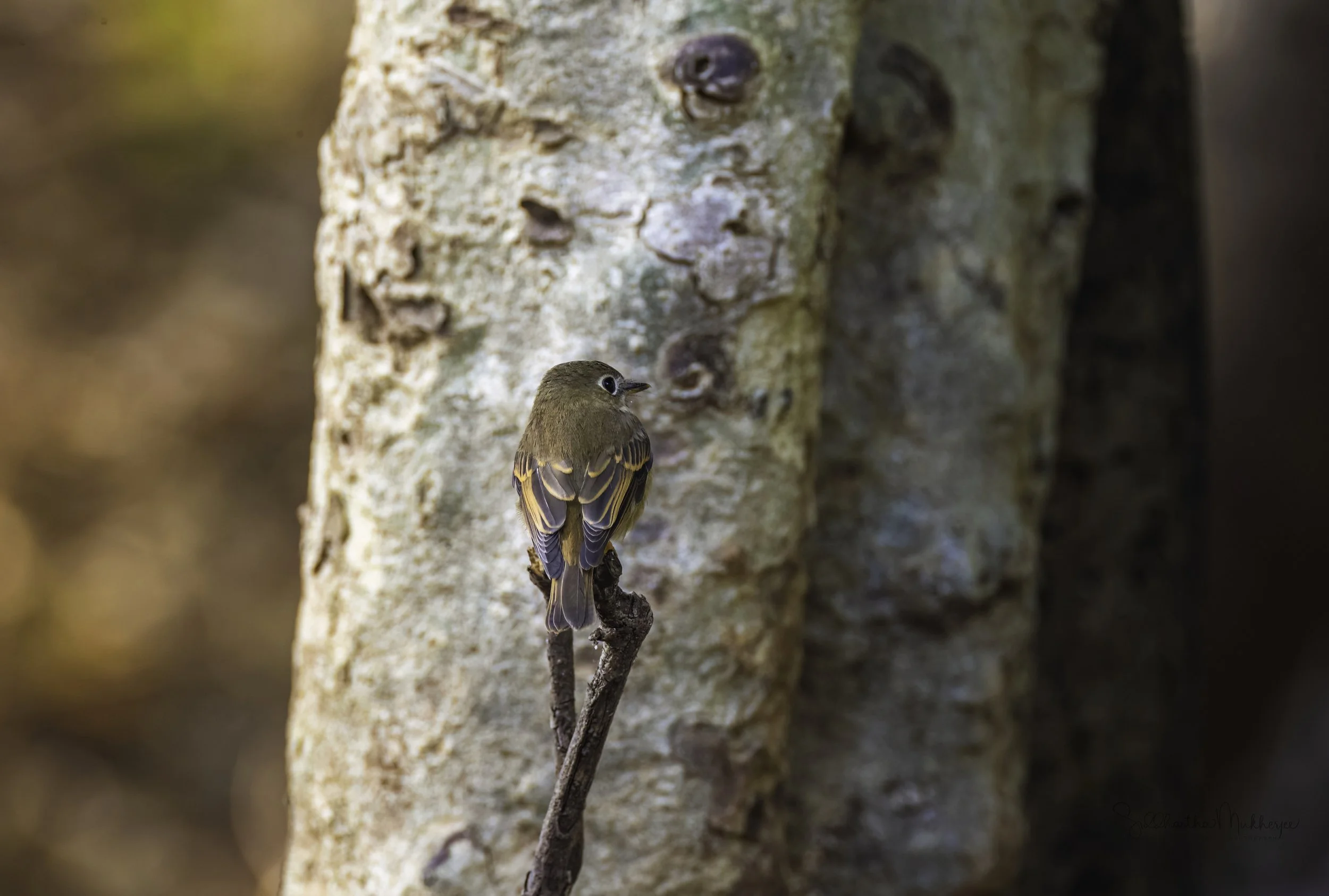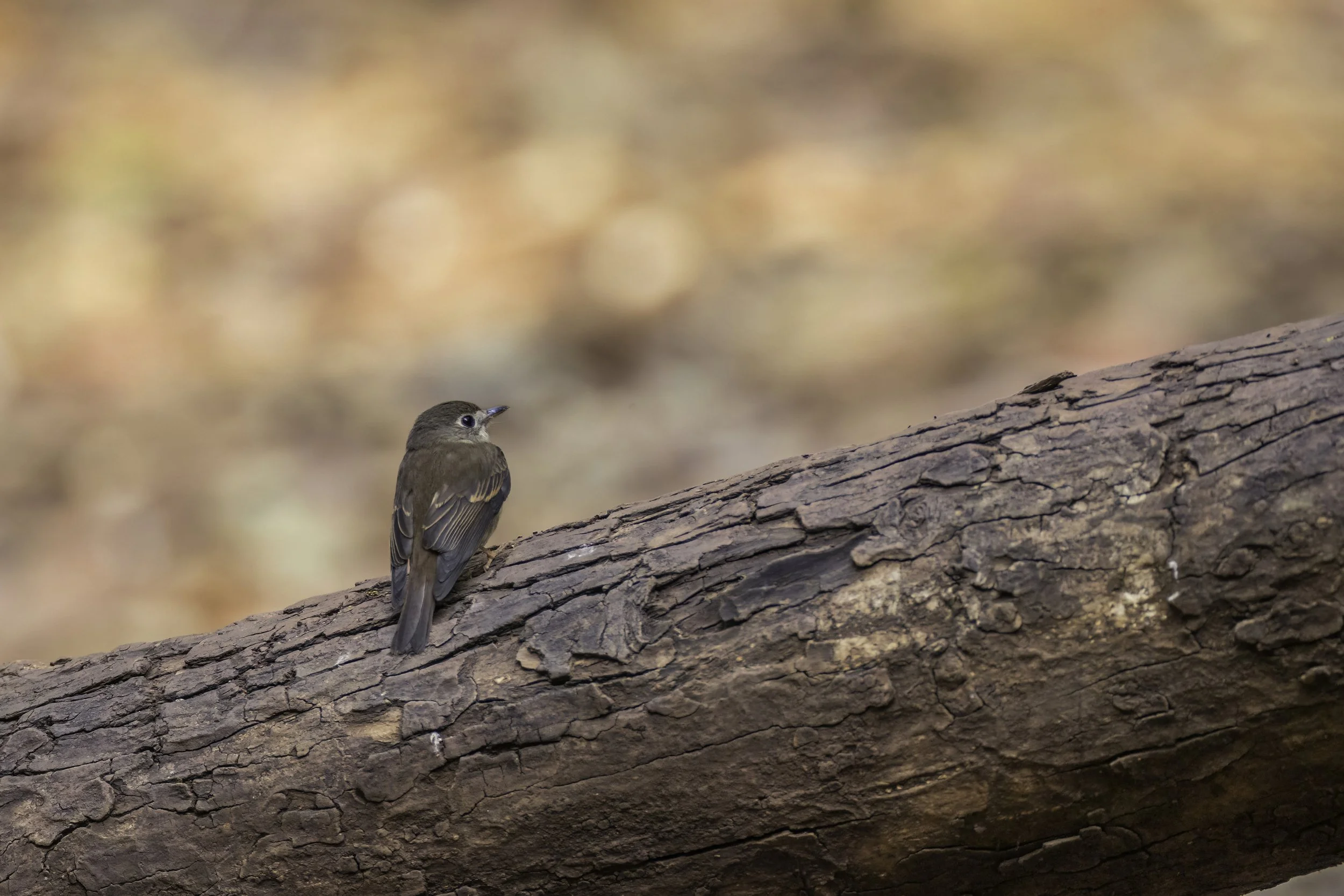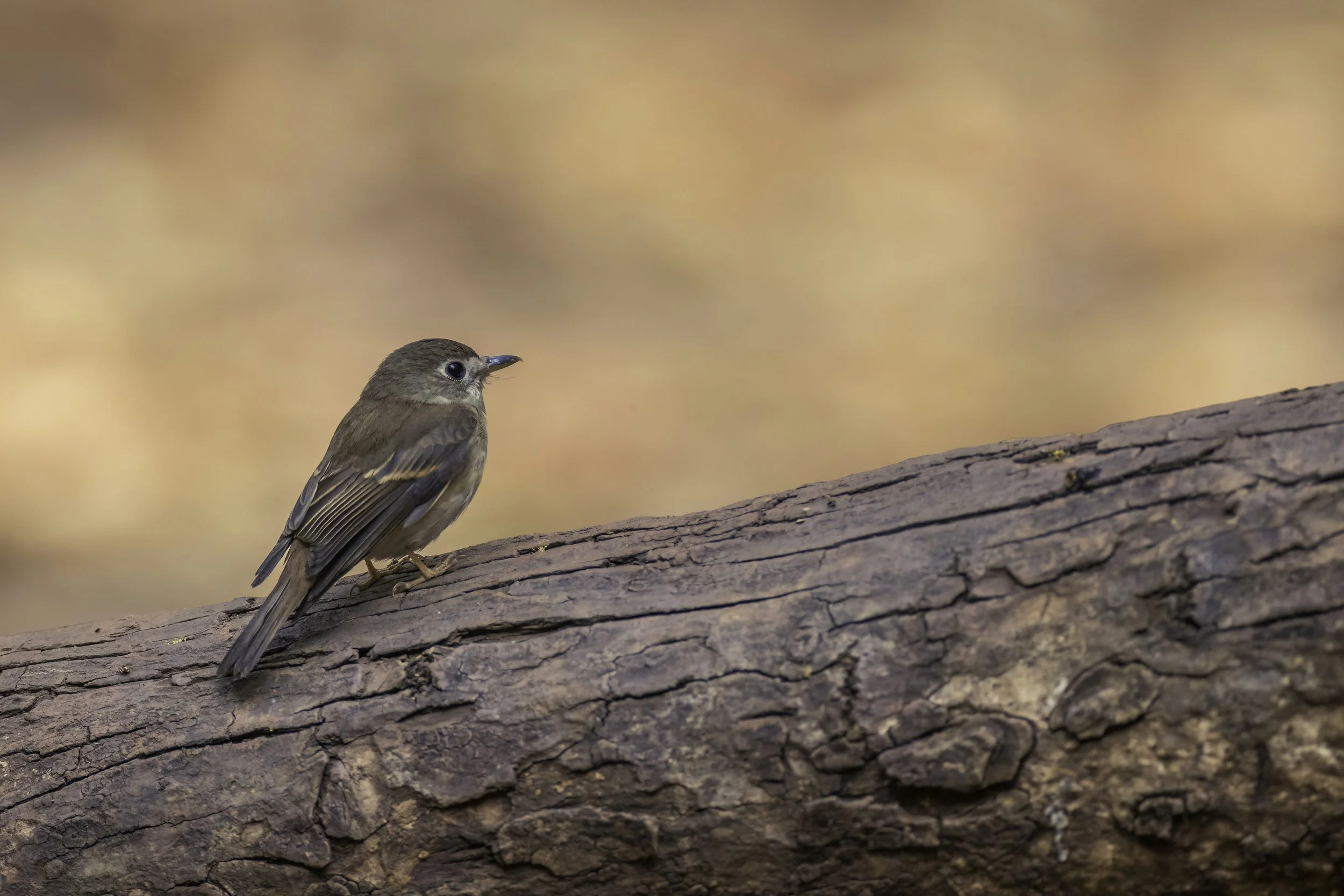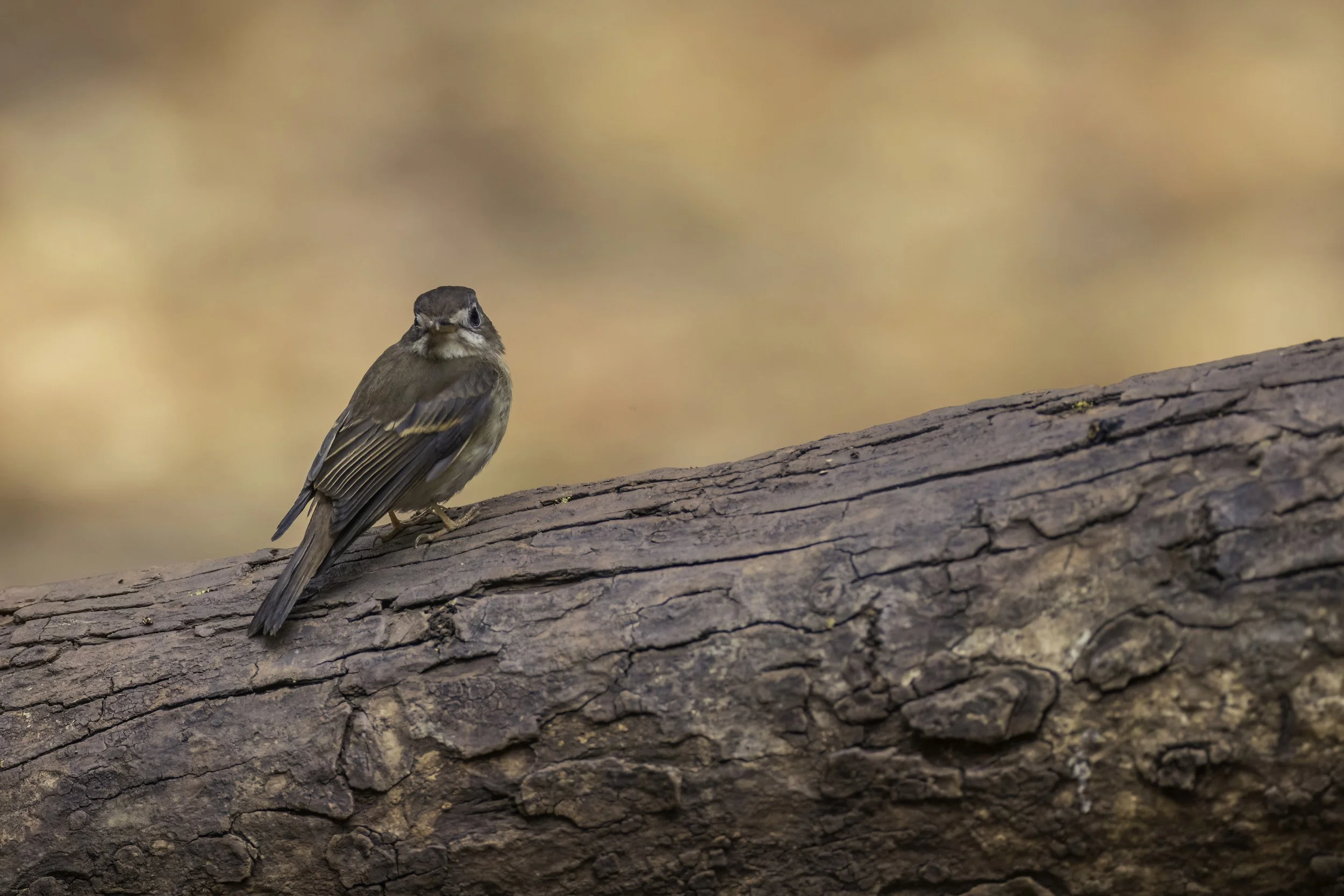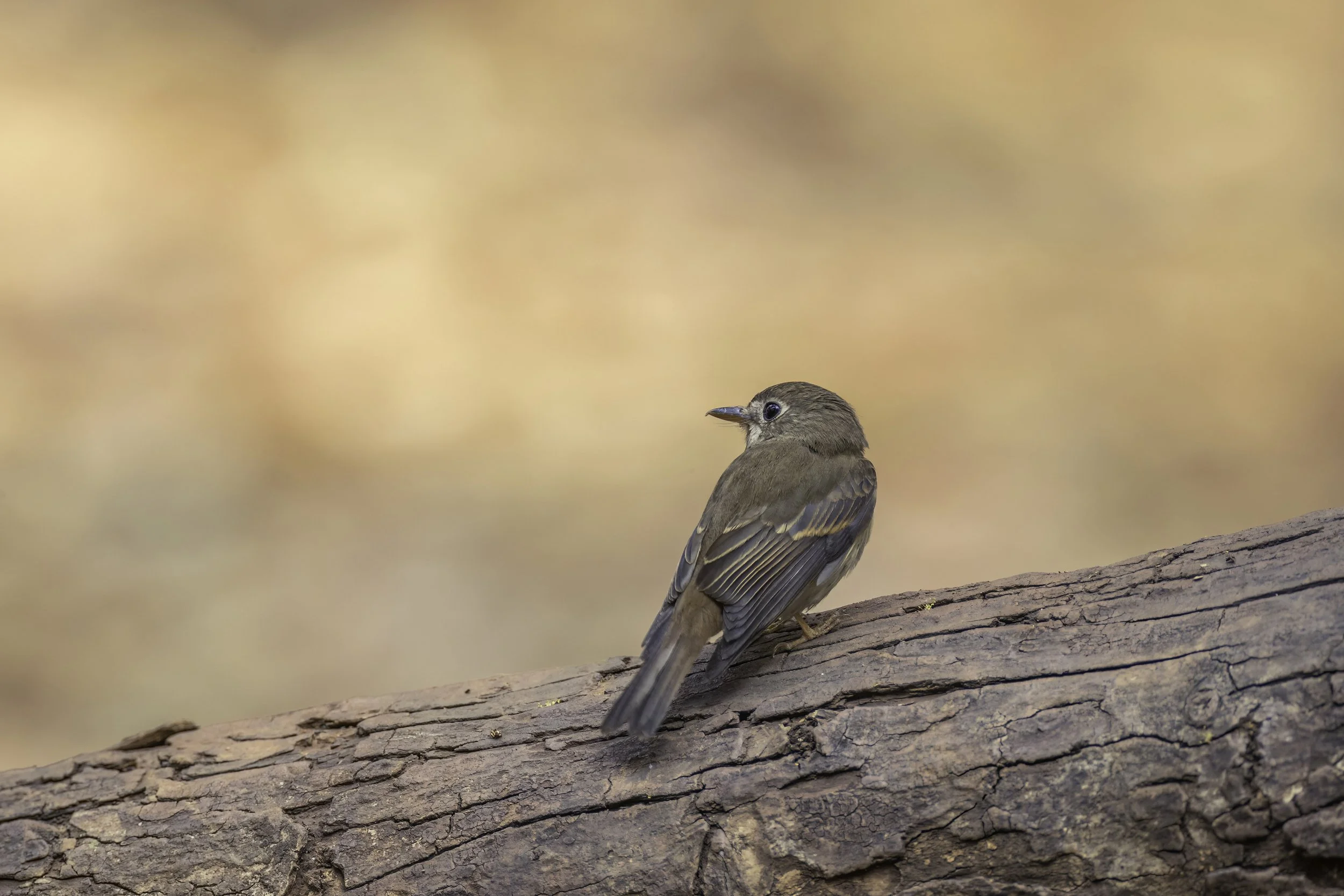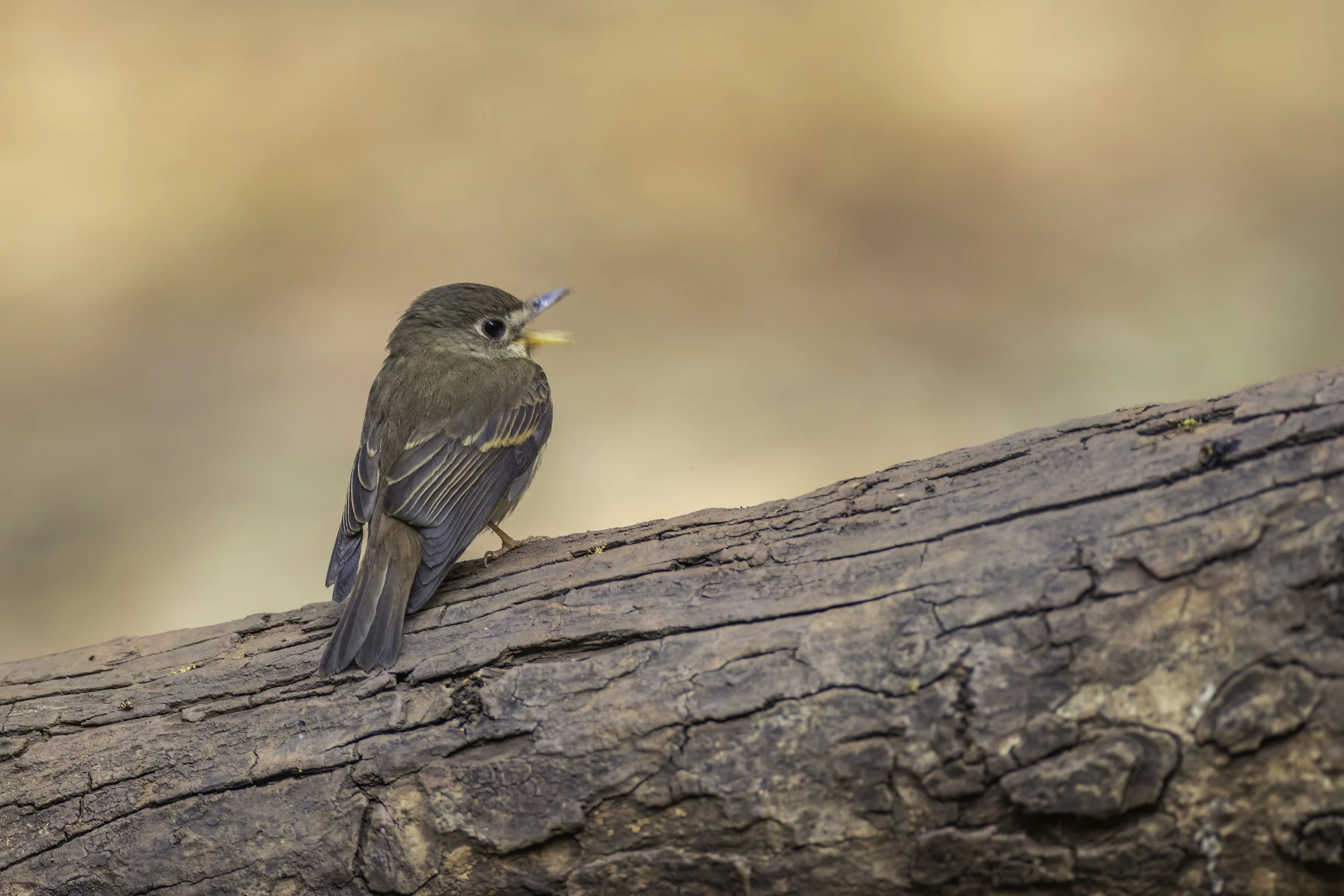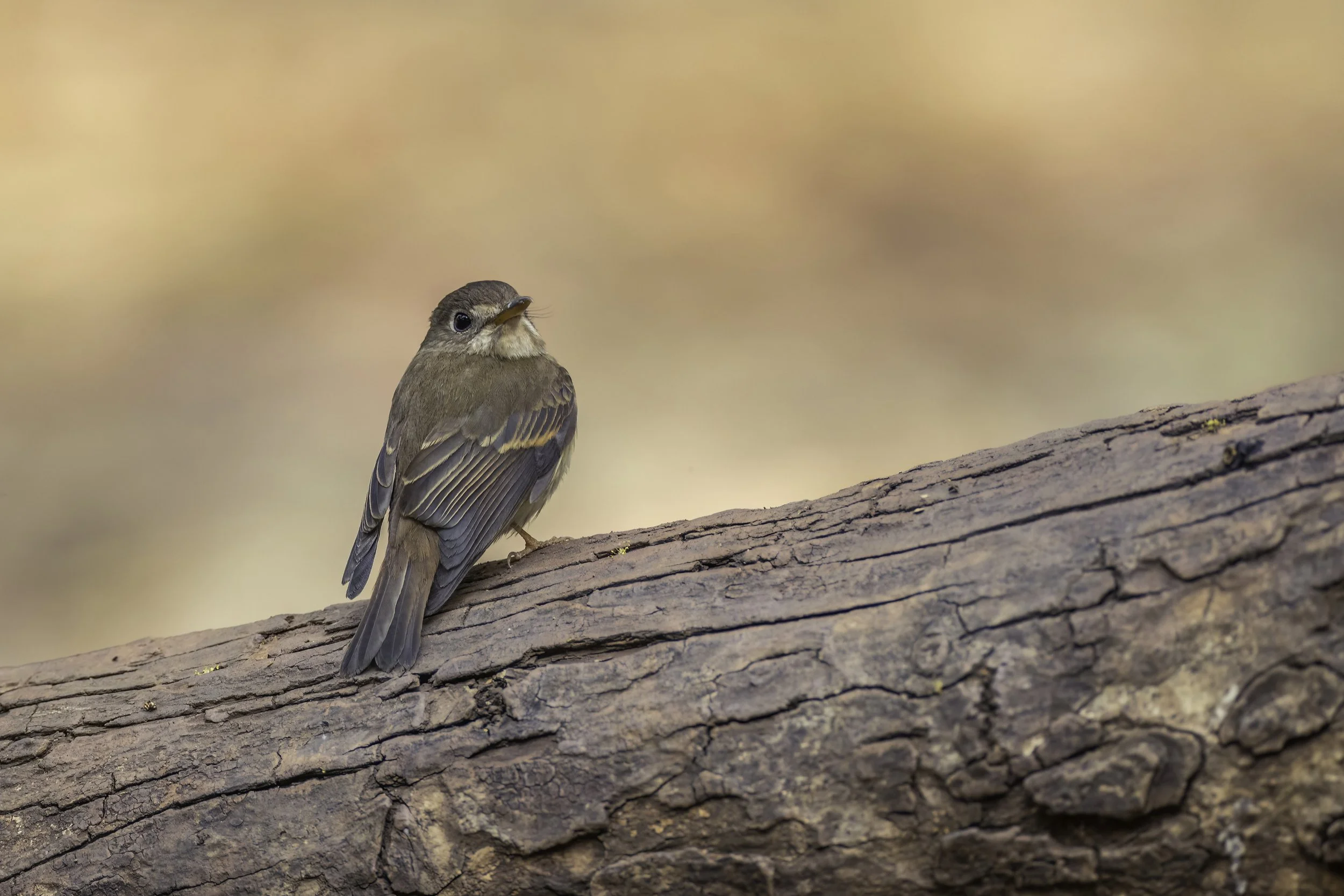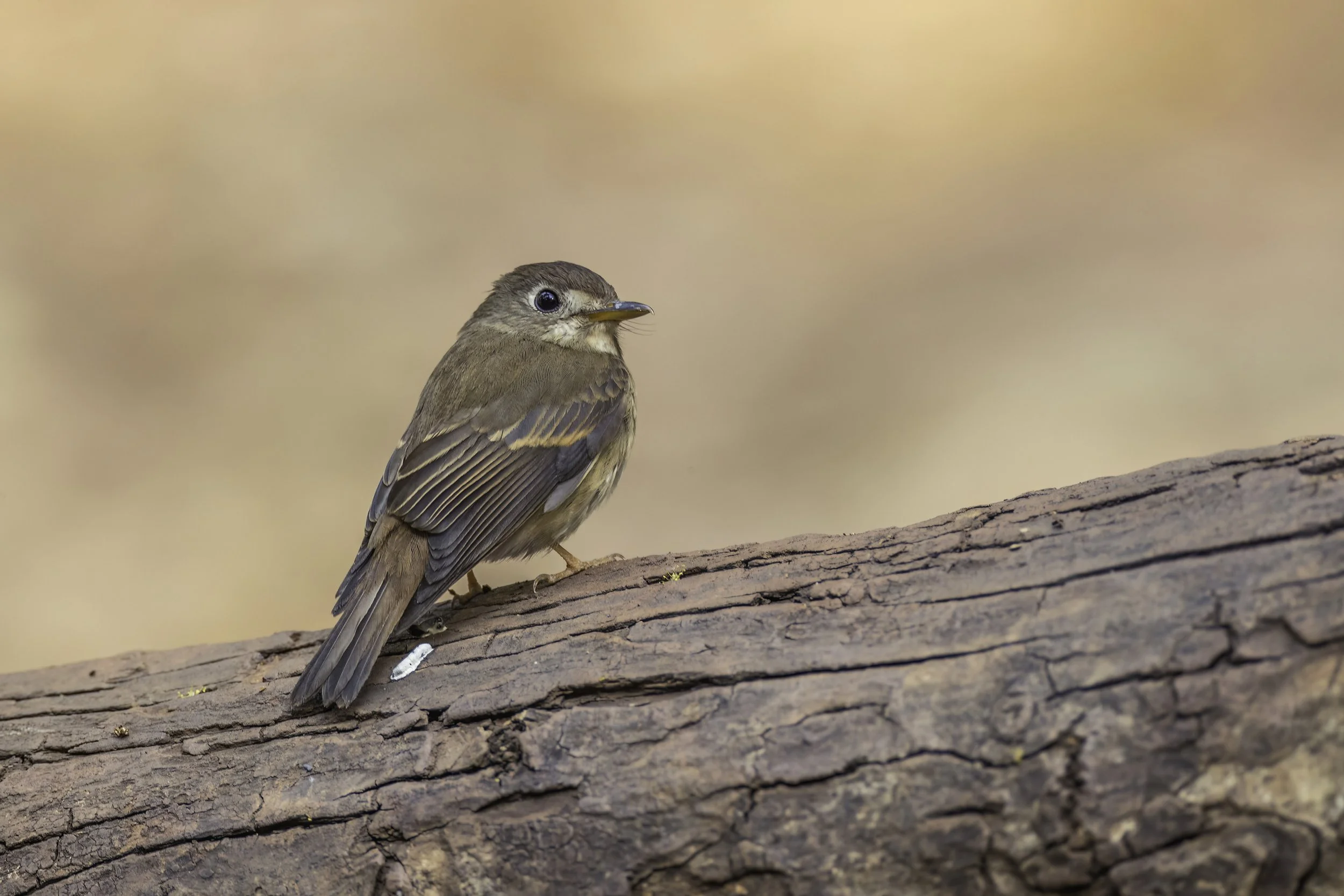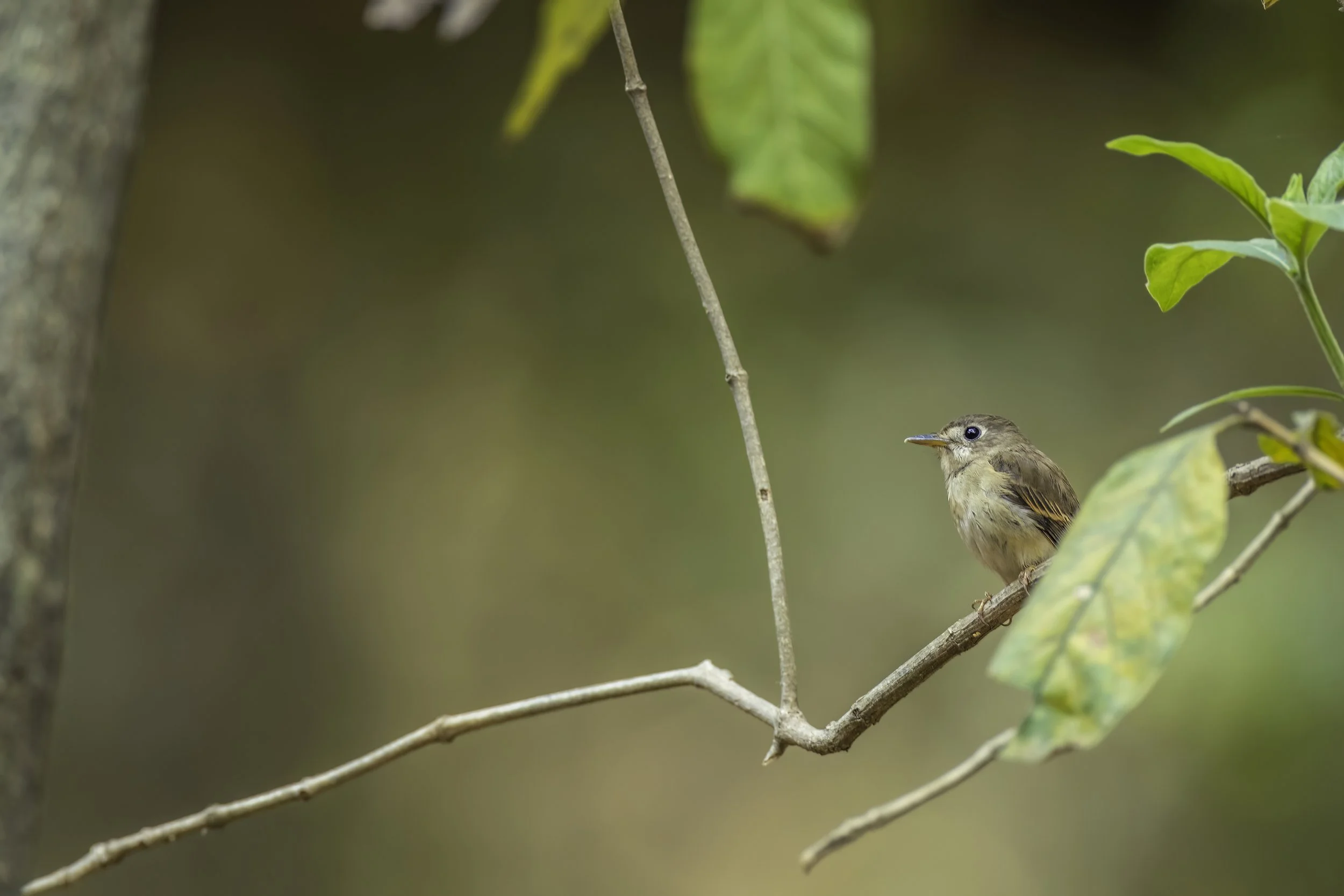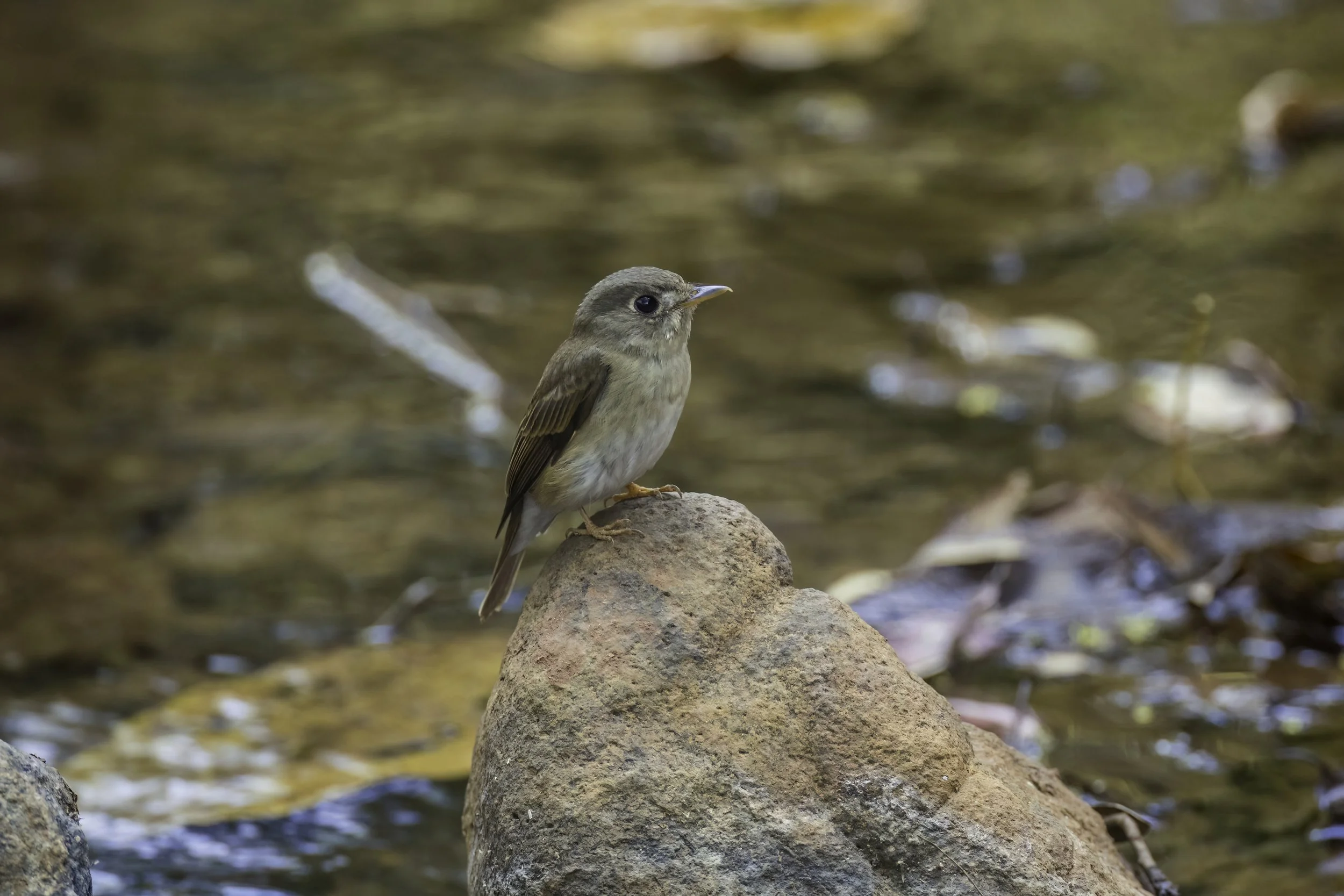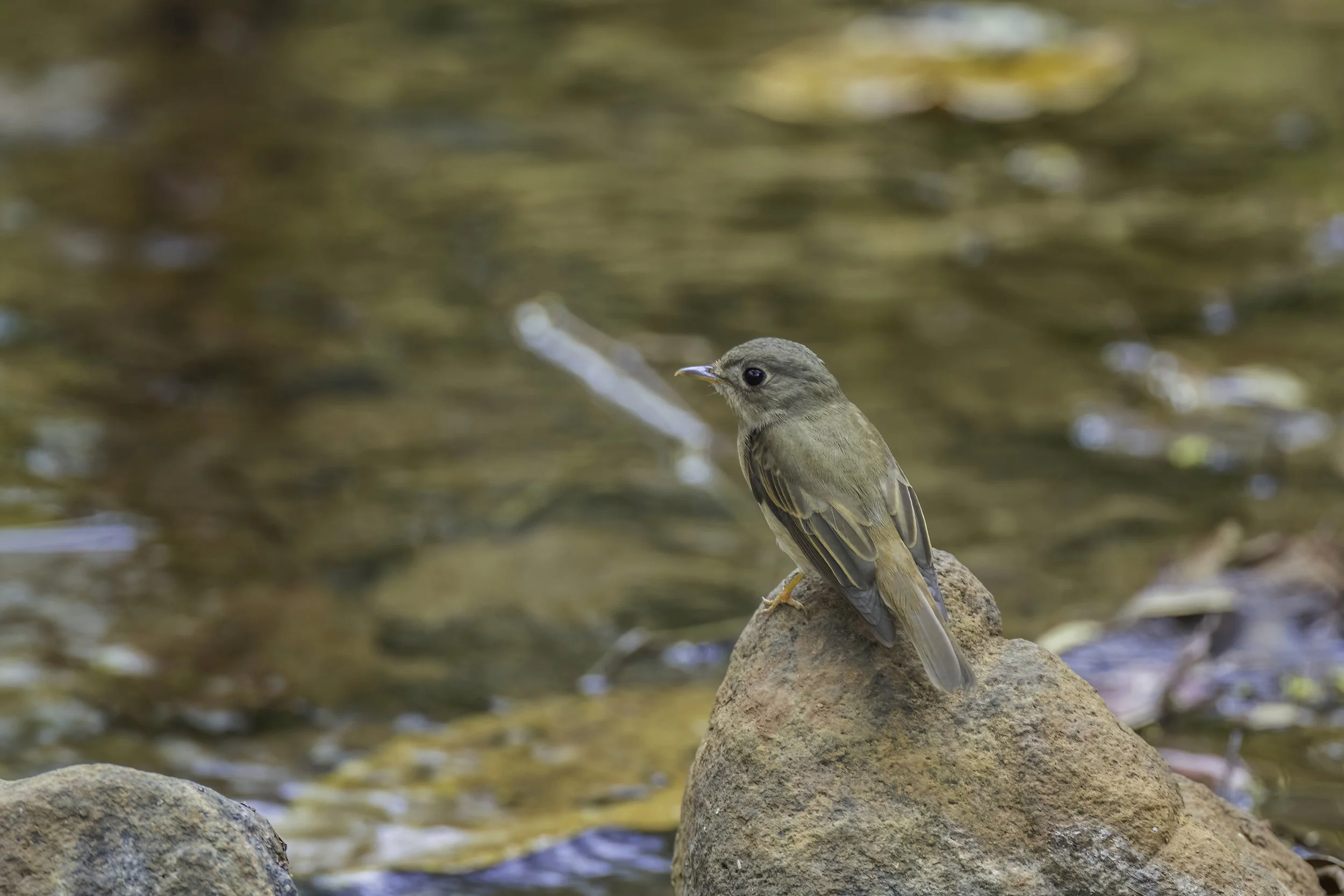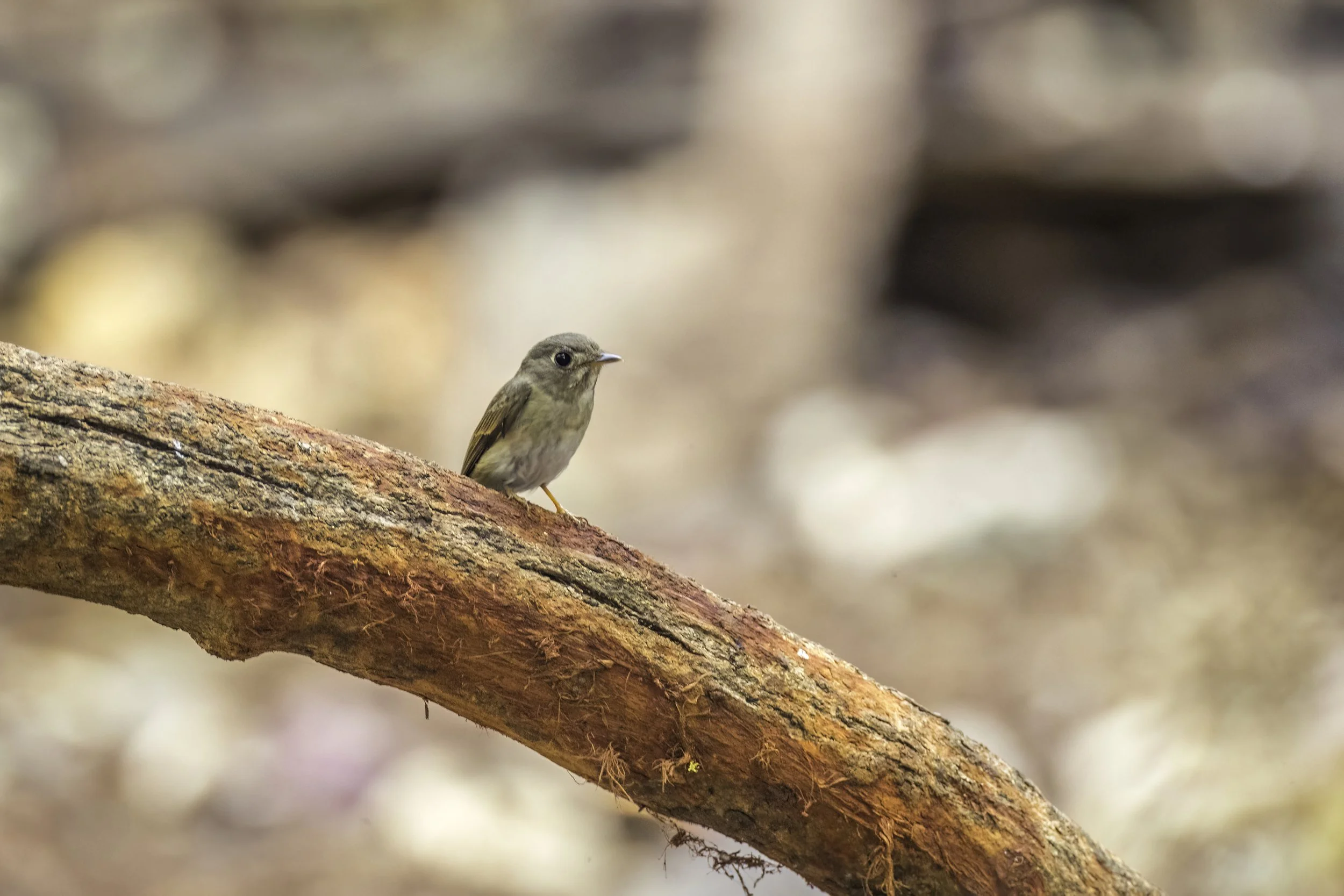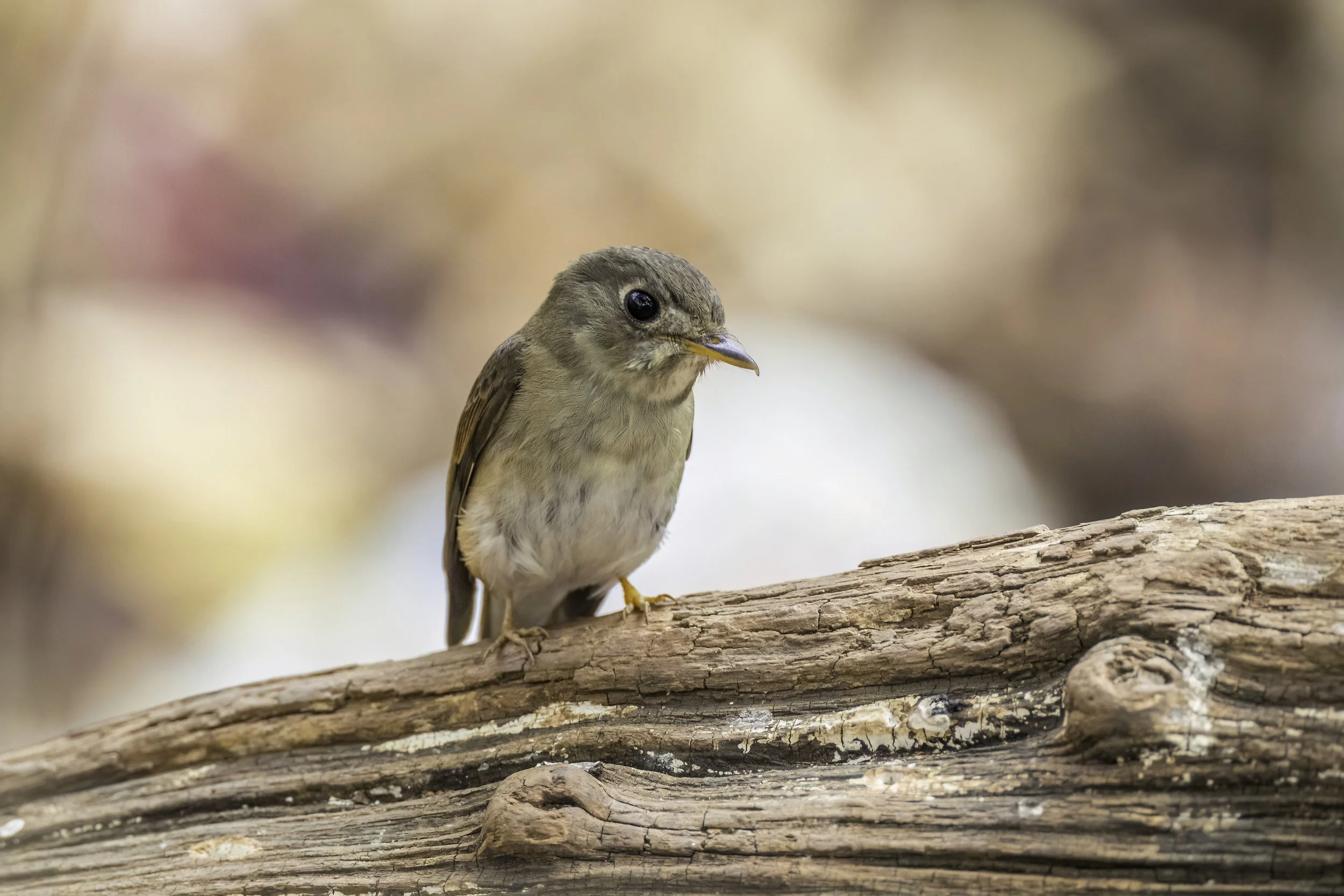Brown-breasted Flycatcher
Muscicapa muttui
Ananthagiri Forest Range, Vikarabad
Another week of exploring deep within the Ananthagiri Forest Range and seeing the cute brown-breasted flycatcher flitting from branch to branch. The Brown-breasted is a dull but rather cute flycatcher, with large white-framed eyes, dark brown above & white below with a gray head, brown flanks, and two distinct dark “moustache” lines. It is similar in general structure and patterning to the Asian Brown Flycatcher, but the Asian Brown’s migratory form is much grayer and lighter-coloured, with weaker “moustache” stripes and less of a brown wash on the flanks, as well as weaker contrast between the head and back.
These beautiful forests of Telangana are, I think, my among my favourite locations to photograph birds because every time I have come here I have found something new. Located in the central stretch of the Deccan Plateau, Telangana has sub-tropical climate and the terrain consists mostly of hills, mountain ranges, and thick dense forests covering an area of 27,292 km². The annual rainfall ranges between 1,100 mm to 1,200 mm and the annual temperature varies from 15 C to 45 C. The State is drained by a number of rivers which include the Godavari and the Krishna.
Telangana is endowed with rich diversity of flora and fauna. It has dense teak forests on the northern part along the banks of river Godavari. As per the Champion & Seth Classification of Forest Types (1968), the forests in Telangana belong to three Forest Type groups, which are further divided into 12 Forest Types. The State Government has taken up a massive greening programme, 'Telangana Ku Harita Haram' in the State to plant and protect 230 crore seedlings over a period of 4 years. This initiative aims at achieving the twin objectives of increasing the forest cover and reduce pressure on the existing forest resources, through massive community participation by Vana Samrakshna Samithis (VSS) and Eco-Development Committees (EDCs) in Protected Areas and Watershed Development Committees in the Watershed areas. Recorded Forest Area (RFA) in the State is 26,904 km² of which 20,353 km² is Reserved Forest, 5,939 km² is Protected Forest and 612 km² is Unclassed Forests. In Telangana, during the period 1st January 2015 to 5th February 2019, a total of 9,420 hectares of forest land was diverted for non-forestry purposes under the Forest Conservation Act, 1980 (MoEF & CC, 2019). As per the information received from the State during that last two years, 12,730 ha of plantations including avenue plantations in the State.
Three National Parks and nine Wildlife Sanctuaries constitute the Protected Area network of the State covering 5.08% of its geographical area and our focus area today is the northern fringe of the Nallamalla forest located both in Telangana and Andhra Pradesh. It is part of the Eastern Ghats. The Nagarjunsagar-Srisailam Tiger Reserve, the largest tiger reserve in India spread over the five districts of Kurnool, Prakasam, Guntur, Nalgonda and Mahabub Nagar falls in its precincts.
Ananthagiri Forest Range
Ananthagiri Hills is located in the Vikarabad district of Telangana. It is one of two major reserve forest blocks of the Vikarabad Forest Range the other one being the Damagundam Forest Reserve and each of these forest blocks is spread over a 10 km² area. While the limits of Damagundam begin from Manneguda, a small town about 60 kms from Hyderabad, Ananthagiri block begins where the limits of Vikarabad end near the railway tracks. The Ananthagiri hills and their dense forests host many wild species like the Nilgai, Sambhar, Black Buck, Chital, Chowsingha, Chinkara, Wild Goats and many more. The streams from these hills flows into Osman Sagar, also known as the Gandipet lake, and Himayath Sagar. It is one of the denser forests in Telangana and is the birthplace (about 5 kilometers from the town of Vikarabad) of the Musi river, also known as the Muchkunda River, which flows through the capital city, Hyderabad. The Musi River after originating in these Ananthagiri Hills, about 90 kilometers to the west of Hyderabad and flowing due east for almost all of its course joins the Krishna River at Wadapally in the Nalgonda district after covering a total distance of about 240 km. Also in these forests is the Sri Anantha Padmanabha Swamy Temple, a Hindu temple dedicated to the Lord Vishnu.
According to the Skanda Purana it is believed this temple was installed by Rishi Markandeya in the Dvapara Yuga. Attracted by the peaceful atmosphere of the Ananthagiri Hills Rishi Markandeya came here for yoga sadhana. It is believed that the Rishi, on the strength of his spiritual powers, would visit Kashi daily for a bath in the sacred Ganges through a cave. One day he was not able to visit Kashi because the Dwadasi was in the early hours of the morning and this prompted Lord Vishnu to appear and give Darshan in a dream and arranged for the Ganges to flow so the Rishi could take his bath daily without having to travel.
About 400 years back the Nizams of Hyderabad used these forests as their hunting grounds. It is said that the Lord Vishnu in the form of Sri Anantha Padmanabha Swamy appeared in a dream and asked the then Nizam, Mir Osman Ali Khan, to build a temple for him. About 20 kilometers from the temple lies the Nagasamudram Lake or Kotipally Reservoir, a masonry dam.
It is one of the earliest habitat areas with ancient caves, medieval fort structures and temples that illustrate the antiquity of this area.
I love these forests as they are home to innumerable bird species, some of which I have photographed and many more which I am yet to photograph. I only hope the so called “bird and nature lovers” who come here to photograph and achieve social media fame adhere to ethical birding practices and refrain from using calls, especially owl calls, and bait. Over the years I have seen the behaviour of the wildlife change in these forests. Birds like this nightjar were easily visible without having to venture deep into the dense brush but now the overload of wildlife enthusiasts has pushed these birds deep into the undergrowth. I think, in a way, it is good for the birds because it requires time and patience to slowly approach them which the modern bird lover/ photographer and nature enthusiast lacks.
Read about the other lovely species I have photographed in the Ananthagiri Forests.
Brown-breasted Flycatcher
The Brown-breasted Flycatcher or Layard's flycatcher (Muscicapa muttui) is a small passerine bird in the flycatcher family Muscicapidae. The species breeds in north eastern India, central and Southern China, northern Burma and Thailand, and migrates to southern India and Sri Lanka. It forages for insects below the forest canopy, often close to the forest floor. The Brown-breasted Flycatcher provides one of the best examples of passage migration (aside from the true passage migrants) within the Indian Subcontinent. It breeds in East Asia and the northern parts of Southeast Asia and migrates westwards and southwards to winter mainly in the Western Ghats and Sri Lanka. During both onward and return passage, the Brown-breasted Flycatcher can be seen in wooded areas across peninsular India, but is seen in especially good numbers in West Bengal and Bangladesh during spring.
Read about the other flycatchers I have photographed.
Source: Birdcount.in. This animated migration map was created from observations uploaded to the citizen science platform eBird up until 2020. Where present, the inset graph depicts the seasonal likelihood of finding this species (i.e. the proportion of eBird checklists) within its range in India alone. We are grateful to the many birdwatchers around the world who have enabled the creation of this animation by sharing their observations on eBird.
This little flycatcher is about 13–14 cm in length and weighs between 10-14 g. The overall colour of the upper parts is olive brown. Some of the feather shafts are darker. The upper tail coverts are brighter rufous as are the edges of the flight feathers. The tail feathers have rufous on the outer webs. The lores are pale and the eye ring is conspicuous. The chin and throat are white while the breast and sides of the body are pale brown. The middle of the body to the vent is buffy white. Submoustachial stripes are faint but mark the boundary of the pale chin while the legs and lower mandible are pale flesh coloured. The most similar species is the Asian brown flycatcher, which has black rather than pale legs. It was named by Edgar Leopold Layard, a British diplomat and naturalist mainly interested in ornithology and to a lesser extent the molluscs, after Muttu, his servant who brought him the specimen.
Although no ringing evidence exists to prove their migration, it is thought that the winter migrants in southern India and Sri Lanka come from north-east India and northern Thailand. A subspecies stötzneri (incorrectly spelt as stotmani by E C Stuart Baker) described from Szechwan by Hugo Weigold in 1922 appears to fall within the range of visible geographic variations and is not usually recognised.
The usual call is very faint tseet audible only at close range or a series of notes chi-chi-chi-chi ending with a low chit-chit.
The Brown-breasted differs from M. dauurica in having olive-brown upper parts, rufous edges on flight-feathers, usually less boldly marked malar stripe. The sexes are alike with the juvenile similar to the adult, but heavily streaked with rufous-buff and blackish on the upper parts and breast, rest of the under parts are whitish, with a dark tip on the lower mandible. The birds with entirely warm buff under parts (including throat) and broad brownish-rufous tips of greater coverts may be first-years.
The brown-breasted flycatcher is distributed from NE India (S Assam hills in Khasi Hills and Nagaland), C & S China (S Gansu S to Yunnan and Guangxi), NW Thailand and N Vietnam, probably also in N & E Myanmar with non-breeding populations in SW India (S from Goa) and Sri Lanka. They prefer broadleaf evergreen forests, between 1200 m and 1645 m; usually below 1400 m in NW Thailand. In non-breeding quarters at 150–500 m; in Sri Lanka, they occur along banks of rivers in lowland forests to 1700 m.
As I’ve mentioned before this is a migratory species spending their non-breeding seasons in SW India (Western Ghats S from Goa) and Sri Lanka; possibly also at lower altitudes in SC China and NW Thailand. The Autumn migration is principally overland through the Eastern Ghats of India and are present in their preferred non-breeding areas between the months of October and March to early April, occasionally to May. They are almost unknown on the spring passage, when the majority presumably cross the Bay of Bengal. They are vagrants in Bangladesh, W Myanmar and N Vietnam (W & E Tonkin).
Their diet is not well known and may include small invertebrates, particularly flies (Diptera) and beetles (Coleoptera). They are usually seen singly or in pairs in the breeding season usually foraging in dense vegetation, including bamboo, and lower levels of forest trees. The Brorwn-breasted is a quiet, retiring and partly crepuscular bird spending long periods almost motionless on a low perch before dashing after a passing insect. have a few photos, like the one above, of these birds on a low branch sitting absolutely motionless for almost 10 minutes. They hold feeding territories in the non-breeding season often in the same locality for long periods.
The breeding season is from April to June and they are territorial. The nest is a neat cup-shaped structure made entirely of moss, placed in dense bush, creepers or low tangled vegetation up to 6 m from ground or on bank in thick cover with a clutch of 4–5 eggs. Both sexes incubate but there is no information on the duration of incubation and fledging periods.
From a conservation perspective the Brown-breasted is not globally threatened but they are scarce to fairly common; rare in China. The status in NE Myanmar and NW Thailand is uncertain indicating they are probably a rare breeding visitor. They are rare and local in Sri Lanka in the non-breeding quarters.
‡‡‡‡‡
For a print of the beautiful birds from my various sojourns click on the button below to read my process and order a limited edition canvas.
‡‡‡‡‡
Related Posts

